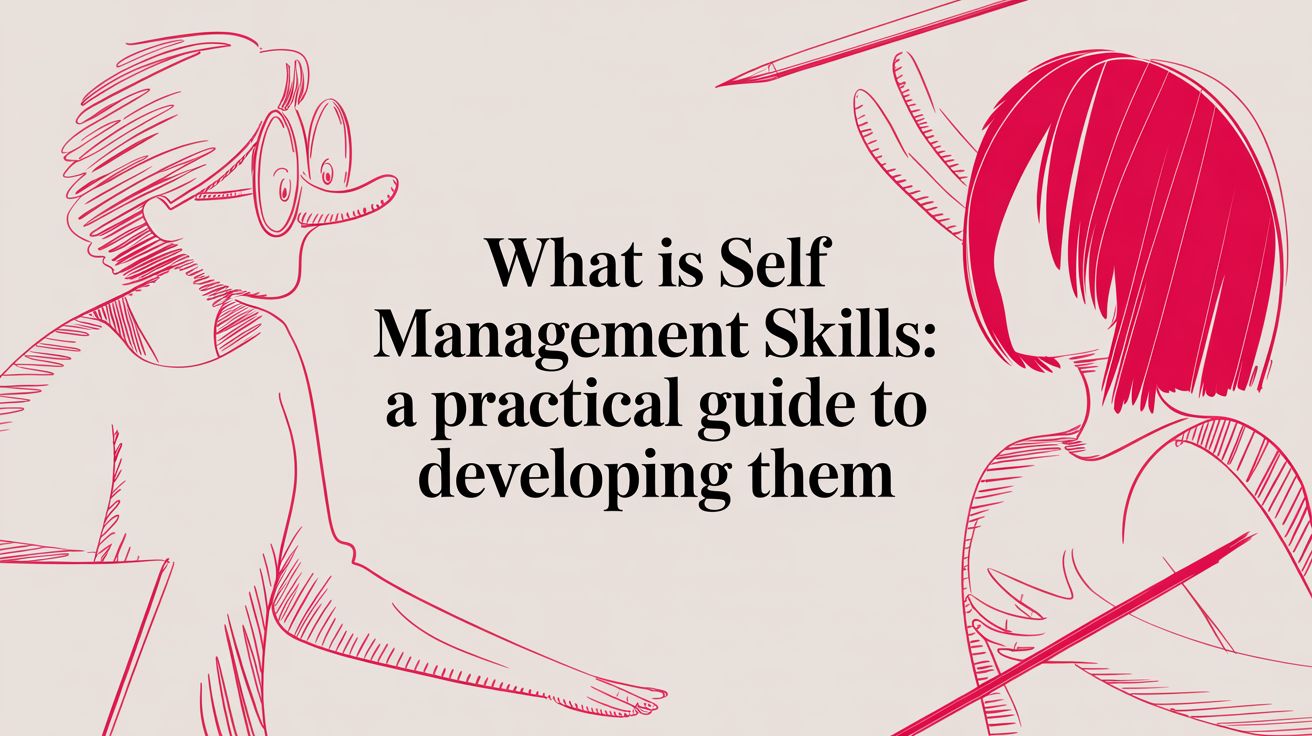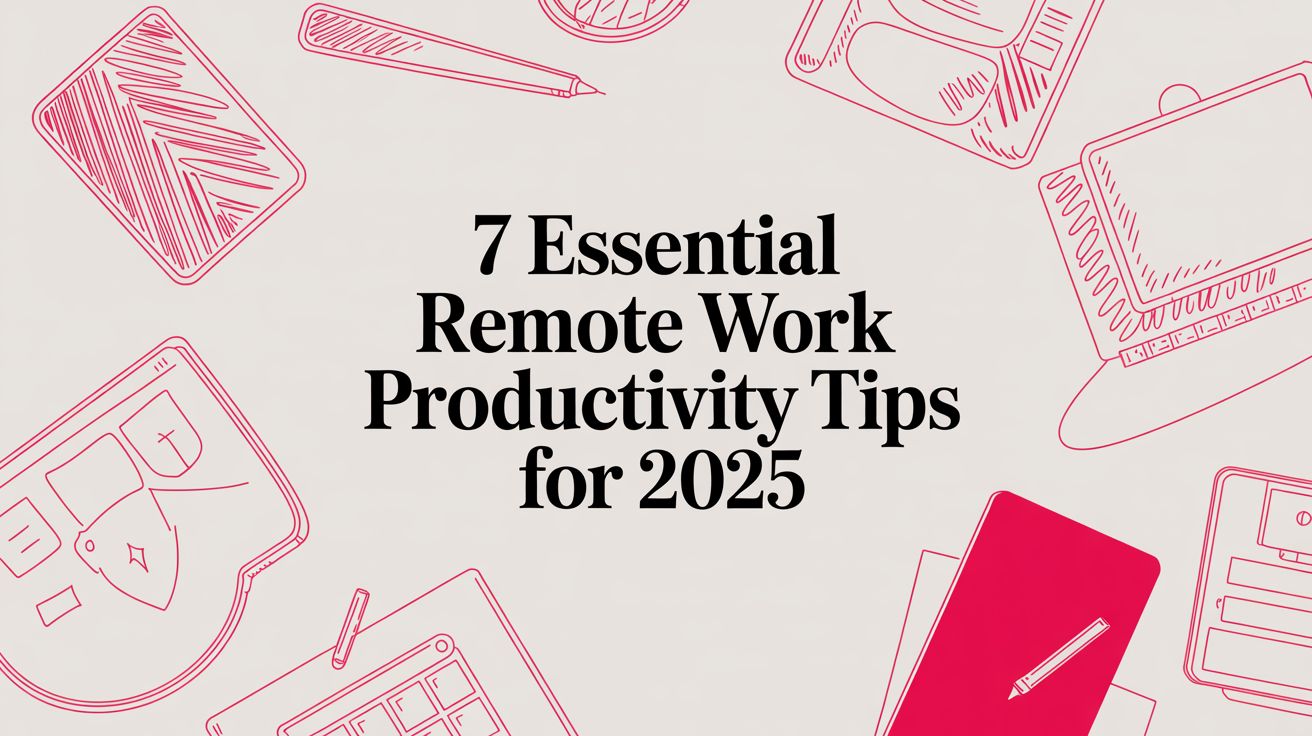How to Handle Difficult Conversations in Remote Teams
Max
Let’s be honest, nobody actually enjoys having tough conversations. In an office, it’s easy enough to put them off. But when you’re working remotely, avoidance becomes even easier—and far more damaging. When you don’t have those daily, in-person interactions, small misunderstandings can quickly spiral into major problems, silently tanking morale and derailing entire projects.
This is exactly why mastering the art of the difficult conversation is a true superpower for any remote team. It’s not about confrontation; it’s about creating connection and clarity. When you can’t rely on body language or a quick chat by the coffee machine to smooth things over, direct and thoughtful dialogue is absolutely essential.
The Hidden Cost of Avoidance
The price tag on putting off these necessary talks is surprisingly steep. Unaddressed conflict is a massive productivity killer. In fact, research shows employees spend an average of 2.1 to 2.8 hours per week just dealing with the fallout from disputes. That adds up to a staggering $359 billion in lost time annually in the U.S. alone.
But it goes beyond the numbers. Avoiding these conversations fosters a culture of ambiguity and anxiety. Team members are left guessing about expectations, performance, or where they stand with their colleagues. That kind of uncertainty is poison for the psychological safety every high-performing remote team needs to thrive. For a deeper dive, you can explore various workplace conflict resolution strategies that can help get everyone on the same page.
The conversations we resist the most are usually the ones we need to have. They create clarity where ambiguity festers and prevent the slow erosion of trust that can cripple a team.
Shifting Your Mindset: From Conflict to Opportunity
The first real step to getting good at this is a mental one. You have to stop thinking of these talks as negative, awkward confrontations. Instead, start seeing them for what they really are: strategic opportunities.
Opportunities to:
- Clarify Expectations: This is your chance to make sure everyone is aligned on goals, roles, and responsibilities, leaving no room for guesswork.
- Strengthen Relationships: Handling disagreements with respect and genuine empathy is one of the most powerful ways to build trust. Our guide on building trust in virtual teams has more great tips on this.
- Drive Growth: Constructive feedback, even when it’s hard to deliver, is the fuel for both individual and team improvement.
When you reframe the purpose, the whole process feels less intimidating. You’re not picking a fight; you’re building a stronger, more resilient team. You’re turning a moment of potential friction into a moment of genuine alignment.
This table provides a quick reference for how to approach these conversations from the very beginning.
Quick Guide to Initiating a Difficult Conversation
| Phase | Key Action | Goal |
|---|---|---|
| Preparation | Define your one clear objective for the talk. | To enter the conversation with focus and a single, achievable outcome in mind. |
| Invitation | Schedule a dedicated video call, providing context but not overwhelming detail. | To create a psychologically safe space and give the other person time to prepare. |
| Opening | Start with a positive, shared goal and state your intention clearly. | To set a collaborative tone and frame the conversation as a problem-solving session. |
By following this simple structure, you’re not just hoping for the best—you’re strategically setting the stage for a productive and positive outcome.
Setting the Stage for a Successful Conversation
The outcome of a tough conversation is often decided long before anyone even joins the video call. Getting your head in the right space beforehand shifts the whole dynamic. Instead of just reacting to whatever comes up, you’re proactively guiding the chat toward a solution. This is your game plan for walking into that talk centered and prepared.

Let’s be honest, the mental energy you spend worrying about these talks is often way more draining than the conversation itself. When you prepare thoughtfully, you replace all that anxiety with a clear sense of purpose. That control is everything.
Define Your Single Most Important Objective
First things first, you need to get crystal clear on your goal. Before you do anything else, ask yourself: “If this conversation accomplishes only one thing, what does it absolutely have to be?” This isn’t about airing a laundry list of grievances. It’s about nailing down the one outcome that truly moves the needle.
Is it to get a firm commitment on meeting deadlines? To clarify a team member’s murky role on a project? Or maybe it’s just to understand why their communication has been so spotty lately.
Whatever it is, your objective needs to be:
- Specific: Don’t aim for something vague like “better communication.” Instead, shoot for something concrete, like “agree on a new process for daily Slack updates.”
- Solution-Focused: The goal isn’t to vent about the past. It’s to build a bridge to the future.
This single objective becomes your North Star. When the conversation gets heated or goes off the rails—and it might—you can use it to gently pull things back to center.
Separate Facts from Feelings
Your emotions are completely valid, but they aren’t facts. This is especially true in a remote setting where you can’t read body language, making it dangerously easy to let assumptions run the show. You have to draw a hard line between what you feel and what you can objectively prove.
Let’s break it down:
- Feeling: “I feel like Alex doesn’t respect my time.”
- Fact: “Alex has been more than 15 minutes late to our last three scheduled one-on-one calls.”
See the difference? Grounding the conversation in observable behavior makes your points almost impossible to dispute. It shifts the discussion from “you’re a bad person” to “let’s look at this situation together.” This simple change is key to creating a space where real dialogue can happen without triggering instant defensiveness.
By focusing on concrete examples, you invite the other person to analyze a situation with you, rather than forcing them to defend their character.
Anticipate Their Perspective
Okay, last step before the actual talk: take a minute and put yourself in their shoes. Based on the facts you’ve laid out, what’s their side of the story likely to be? This isn’t about making excuses for them. It’s about strategic empathy.
Think about what might be going on behind the scenes. Are they totally swamped with work? Grappling with a personal issue you don’t know about? Or are they just genuinely unclear on what’s expected of them?
Walking through these possibilities prepares you to handle their responses with empathy instead of shock. When you go into a conversation having already considered their angle, you’re way better equipped to listen and find a solution that actually works for everyone. This prep work turns a potential fight into a real partnership.
Diagnosing the Real Issue Before It Escalates
Difficult conversations are almost always just the tip of the iceberg. That awkward chat you need to have about missed deadlines? It’s not the real problem. It’s a symptom of something deeper that’s gone off the rails.
To get good at handling these moments, you have to train yourself to see past the immediate frustration and figure out what’s actually broken. This is especially true when you’re working remotely, where small bits of friction can go unnoticed until they suddenly explode. The key is to stop being reactive and start diagnosing the root cause before it has a chance to fester.
The Common Culprits Behind Workplace Conflict
Most disagreements at work don’t just pop up out of nowhere. They usually trace back to a few predictable triggers that create a perfect storm for tension and misunderstanding. When you look at the research, a clear pattern emerges—most disputes are tied directly to how people behave and interact.
A massive 73% of conflicts are sparked by a lack of trust, which is the absolute bedrock of any high-functioning team. Right behind that are personality clashes (72%) and a lack of role clarity (70%), which is when fuzzy responsibilities lead to crossed wires and resentment. In fact, personality differences alone are blamed for nearly half of all workplace conflicts. You can see more data on these conflict triggers and get other insights from the folks at Evolve.
These problems get amplified when everyone is distributed. You can’t build the same daily rapport you would in an office, so trust is harder to earn and much easier to lose. And those vague role descriptions? They become ten times more confusing when you can’t just lean over a desk to ask a quick question.
Proactive Strategies for Prevention
Figuring out the common triggers is the first step. Taking action to prevent them is what really matters. If you want to build a resilient remote team, you have to actively work on strengthening these potential weak points before they crack.
Here are a few proactive strategies you can put into play:
- Over-Communicate Roles and Responsibilities: Don’t just toss a task over. Clearly define what success looks like, who owns which piece of the puzzle, and what the dependencies are. Use shared documents to make this information visible and easy for anyone to find.
- Schedule Non-Work Interactions: Make time for virtual coffee chats or team activities that have nothing to do with a project deadline. These moments are where you build the personal connections that create trust and help different personalities click.
Trust is the currency of a remote team. Every action you take to build it is a direct investment in preventing future conflicts. It’s the invisible infrastructure that holds everything together when you’re not in the same room.
Learning how to handle difficult conversations gets a lot easier when you have fewer of them to begin with. By focusing on these preventative measures, you’re not just getting better at putting out fires—you’re building a team where fires are less likely to start in the first place. For more on creating that strong foundation, check out our guide on remote work best practices.
How to Navigate the Conversation with Empathy
Alright, this is where all your prep work pays off. You’ve figured out the core issue and what you want to achieve. Now, it’s time for the actual conversation. Leading this kind of dialogue, especially when you’re remote and can’t read the room, demands a specific set of skills—think empathy, active listening, and keeping your own emotions in check.

Remember, the goal isn’t to “win.” It’s to steer the conversation toward a solution where you both feel respected and understood. This mindset is what turns a potential blow-up into a productive, problem-solving session.
Use “I” Statements to Share Your Perspective
The way you start this conversation sets the tone for everything that follows. Kicking things off with “you did this” or “you always…” is a surefire way to put someone on the defensive. It just doesn’t work.
Instead, frame your points from your perspective using “I” statements. This isn’t about sugarcoating; it’s about focusing on the impact of a behavior on you or the team, not judging the person’s character or intentions.
Let’s look at a couple of examples:
Instead of: “You missed the deadline again.”
Try: “I was concerned when the project milestone wasn’t met because it impacts our team’s timeline.”
Instead of: “You weren’t clear in your email.”
Try: “I had trouble understanding the next steps from the email, and I want to make sure I’m on the right track.”
It’s a subtle shift, but it’s incredibly powerful. You’re presenting a shared problem to solve together, which invites collaboration instead of conflict. It’s a foundational skill, and you can explore more ways to improve your communication skills at work in our detailed guide.
Practice Active Listening in a Virtual World
When you’re remote, you lose a lot of the classic body language cues like nodding or direct eye contact that show you’re engaged. You have to be much more intentional about showing you’re listening. That means giving them your full, undivided attention—no checking Slack notifications or emails on another screen.
Here’s how to prove you’re dialed in:
Paraphrase and Summarize: After they’ve shared their side, repeat back what you heard in your own words. You could say something like, “So, if I’m hearing you correctly, you’re feeling overwhelmed by the workload because of X and Y. Is that right?” This simple step validates their feelings and confirms you’re on the same page.
Ask Open-Ended Questions: Encourage them to elaborate by asking questions that can’t be answered with a simple “yes” or “no.” Try things like, “Can you walk me through your process on that task?” or “What would ideal support look like for you on this project?”
This isn’t just about being polite. It’s about digging for the information you need to find a real, lasting solution. Interestingly, these same principles are the bedrock of many effective strategies for managing conflict in relationships outside the office, too.
When you approach a difficult conversation with genuine curiosity instead of judgment, you create a safe space for honesty. This is where real progress happens.
Stay Focused on Shared Success
Here’s an encouraging thought: most people actually want to collaborate. A global survey revealed that 59.8% of professionals prefer a collaborative style when dealing with conflict, and 55.7% prioritize restoring harmony with their colleagues.
You can lean into this natural inclination by consistently bringing the focus back to your shared goals. When things get heated or go off-track, use that common ground as your anchor.
Phrases like, “We both want this project to succeed” or “Our main goal here is to create a workflow that supports everyone” can instantly de-escalate tension. They serve as a powerful reminder that you’re on the same team, working toward the same finish line.
Creating a Clear Path Forward After the Talk

The difficult conversation doesn’t really end when you click “Leave Meeting.” In many ways, the most important part is what comes next. A productive talk can quickly lose its value if it doesn’t translate into tangible action.
The goal now is to turn that hard-won understanding into a concrete plan both of you can commit to. This step is all about cementing the progress you made. Without a clear follow-up, you risk misunderstandings or having the same issue resurface in a few weeks. A simple, well-crafted summary ensures your conversation leads to lasting change, not just a temporary truce.
Document the Outcomes and Next Steps
Immediately after the conversation, while it’s still fresh in your mind, draft a brief follow-up email. This isn’t about re-litigating the discussion or assigning blame. It’s about creating a neutral, shared record of the solutions you agreed upon.
Keep it simple and forward-looking. The tone should be collaborative and positive, reinforcing the idea that you’re moving forward together.
A good follow-up email should include:
- A quick thank you: Start by thanking them for their time and candor.
- A summary of key takeaways: Briefly list the main points of your agreement.
- Clearly defined action items: Detail who is responsible for what, and by when.
This email becomes your accountability tool. It’s a reference point that helps ensure everyone sticks to the plan and that your efforts in how to handle difficult conversations result in real progress. For more advice on building this kind of accountability, our guide on creating a strong remote work culture provides strategies that actually work.
A follow-up email isn’t just a summary; it’s a commitment. It transforms a verbal agreement into a tangible roadmap for change, making it much harder for good intentions to fall through the cracks.
When You Can’t Find a Resolution
What happens if, despite your best efforts, you hit a wall? Sometimes, you simply can’t reach an agreement on your own. If the conversation ends in a stalemate or if the other person is unwilling to meet you halfway, it might be time to escalate the issue.
This isn’t a sign of failure. It’s a recognition that the problem requires a different level of intervention. The key is to know when to ask for help.
Looping in a Manager or HR
If you’ve tried to resolve the conflict directly and haven’t succeeded, or if the issue involves serious matters like harassment or breaches of company policy, bringing in a third party is the correct next step.
Consider escalating if:
- The agreed-upon actions are not being followed.
- The conversation became hostile or unproductive.
- The root issue is beyond your authority to resolve.
Approach your manager or HR with the same fact-based mindset you used for the initial conversation. Explain the situation calmly, detail the steps you’ve already taken to resolve it, and be clear about the outcome you were hoping for. This provides them with the context they need to step in effectively and help find a resolution.
Common Questions About Handling Tough Talks
Even with the best game plan, you’re bound to hit a few snags in a tough conversation. These moments can throw you off balance and make you question your entire approach. Honestly, a huge part of getting better at this is just having a few go-to responses in your back pocket for when things get weird.
Let’s walk through some of the most common questions that pop up.
What If The Other Person Gets Angry or Emotional?
When the emotional floodgates open, the single best thing you can do is… nothing. Just pause. Give them the space to get it out without you jumping in to fix it or, even worse, telling them to “calm down.” We all know that line has a 100% failure rate.
Instead, your job is to acknowledge what’s happening without getting tangled up in it. A simple, neutral statement works wonders here. Try something like, “I can see this is really frustrating for you,” or “I hear how upsetting this is.” You’re validating their feelings, which is different from agreeing with their argument.
Once you’ve done that, you can gently guide the conversation back to the objective facts and the shared goal you hopefully established at the start.
If the conversation just isn’t going anywhere productive, it’s completely okay to call a timeout. Suggesting a 15 or 30-minute break gives both of you a chance to cool off and come back with a clearer head.
Acknowledging someone’s feelings isn’t the same as agreeing with their argument. It’s about showing respect and creating the psychological safety needed to move forward productively.
How Do I Start The Conversation Without Making Them Defensive?
The first 30 seconds are everything. You have to frame this as a partnership, not an attack. Starting with phrases like “you always” or “you never” is a surefire way to put someone on the defensive before you even get to the real issue.
Your opening line should be forward-looking and collaborative. Think about it from their perspective.
- “I’d like to chat about how we can improve our workflow on the X project.”
- “I really value your contributions, and I want to make sure we’re fully aligned on our next steps.”
This kind of opener immediately signals that you see them as a partner in finding a solution, not as the problem itself. It’s all about creating a safe space for an honest chat, which is a skill that’s closely related to learning how to ask for feedback at work and get it.
Which Communication Channel Is Best For Remote Teams?
For any conversation that has even a small chance of getting emotional, you have to use the highest-fidelity channel available. For remote teams, that means a video call is non-negotiable.
Seriously. Being able to see someone’s facial expressions and body language provides a universe of context that’s completely vaporized over text. A phone call is a very, very distant second-best option.
Whatever you do, don’t even think about having a difficult conversation over email or a messaging app like Slack. Text strips out all the nuance and tone, making misinterpretations practically guaranteed. It’s just not the right tool for handling the delicate dynamics of a tough talk.
At Remote First Jobs, we’re dedicated to helping you build a successful remote career, from finding the right opportunity to mastering the skills needed to thrive. Explore over 40,000 verified remote positions on our platform today. Find your next role at https://remotefirstjobs.com.


